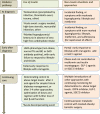Insulin therapy in people with type 2 diabetes: opportunities and challenges?
- PMID: 24855154
- PMCID: PMC5131884
- DOI: 10.2337/dc13-2743
Insulin therapy in people with type 2 diabetes: opportunities and challenges?
Abstract
Given the continued interest in defining the optimal management of individuals with type 2 diabetes, the Editor of Diabetes Care convened a working party of diabetes specialists to examine this topic in the context of insulin therapy. This was prompted by recent new evidence on the use of insulin in such people. The group was aware of evidence that the benefits of insulin therapy are still usually offered late, and thus the aim of the discussion was how to define the optimal timing and basis for decisions regarding insulin and to apply these concepts in practice. It was noted that recent evidence had built upon that of the previous decades, together confirming the benefits and safety of insulin therapy, albeit with concerns about the potential for hypoglycemia and gain in body weight. Insulin offers a unique ability to control hyperglycemia, being used from the time of diagnosis in some circumstances, when metabolic control is disturbed by medical illness, procedures, or therapy, as well as in the longer term in ambulatory care. For those previously starting insulin, various other forms of therapy can be added later, which offer complementary effects appropriate to individual needs. Here we review current evidence and circumstances in which insulin can be used, consider individualized choices of alternatives and combination regimens, and offer some guidance on personalized targets and tactics for glycemic control in type 2 diabetes.
© 2014 by the American Diabetes Association.
Figures
Comment in
-
Comment on Home et al. Insulin therapy in people with type 2 diabetes: opportunities and challenges? Diabetes care 2014;37:1499-1508.Diabetes Care. 2014 Nov;37(11):e245-6. doi: 10.2337/dc14-1632. Diabetes Care. 2014. PMID: 25342842 No abstract available.
-
Response to comment on Home et al. Insulin therapy in people with type 2 diabetes: opportunities and challenges? Diabetes care 2014;37:1499-1508.Diabetes Care. 2014 Nov;37(11):e247. doi: 10.2337/dc14-1790. Diabetes Care. 2014. PMID: 25342843 Free PMC article. No abstract available.
References
-
- Brown JB, Nichols GA, Perry A. The burden of treatment failure in type 2 diabetes. Diabetes Care 2004;27:1535–1540 - PubMed
-
- Shah BR, Hux JE, Laupacis A, Mdcm BZ, Austin PC, van Walraven C. Diabetic patients with prior specialist care have better glycaemic control than those with prior primary care. J Eval Clin Pract 2005;11:568–575 - PubMed
-
- Home P, Naggar NE, Khamseh M, et al. . An observational non-interventional study of people with diabetes beginning or changed to insulin analogue therapy in non-Western countries: the A1chieve study. Diabetes Res Clin Pract 2011;94:352–363 - PubMed
-
- Peyrot M, Rubin RR, Lauritzen T, et al. International DAWN Advisory Panel . Resistance to insulin therapy among patients and providers: results of the cross-national Diabetes Attitudes, Wishes, and Needs (DAWN) study. Diabetes Care 2005;28:2673–2679 - PubMed
-
- U.K. Prospective Diabetes Study Group . U.K. prospective diabetes study 16. Overview of 6 years’ therapy of type II diabetes: a progressive disease. Diabetes 1995;44:1249–1258 - PubMed
MeSH terms
Substances
LinkOut - more resources
Full Text Sources
Other Literature Sources
Medical


